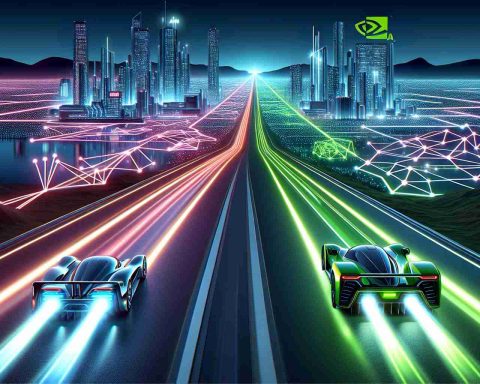- Nvidia dominates the data center and AI processing markets, leveraging its GPUs and CUDA software to lead the industry.
- AMD presents potential competition with impressive GPU specifications, but Nvidia’s entrenched software ecosystem poses a significant barrier.
- Nvidia’s staggering $30.8 billion in Q3 FY 2025 revenue showcases its dominance, surpassing AMD’s noteworthy 122% growth in data center revenue.
- The high costs and complexity of switching from Nvidia’s infrastructure continue to maintain its strong market position.
- Nvidia’s revenue growth is projected to be 52% in the coming fiscal year, compared to AMD’s 24%, indicating continued leadership in the sector.
- Investors are drawn to Nvidia’s robust market position, despite higher valuations, viewing it as the stronger play in AI and computing.
Nvidia stands as the reigning monarch in the data center realm, wielding its crown with confidence amid the AI gold rush. The world of artificial intelligence, with its insatiable appetite for data processing, has proved to be a lucrative playground for this tech titan. As dollars flow like rivers into AI infrastructure, Nvidia’s GPUs and proprietary CUDA software have emerged as the industry benchmarks, effortlessly handling the monumental calculations AI demands.
Across the field, AMD eyes the throne, armed with GPUs that might dazzle on paper. Yet, the towering barrier is Nvidia’s software ecosystem, deeply rooted and difficult to uproot. For any contender wishing to dethrone Nvidia, the Herculean task of persuading industry giants to switch allegiance is a formidable challenge.
The numbers tell a compelling story. While AMD celebrates a commendable surge in its data center revenue, nearly doubling with a 122% year-over-year rise, Nvidia’s figures are nothing short of staggering—tenfold the size, with a $30.8 billion record in Q3 FY 2025. The moat surrounding Nvidia grows wider, its waters filled with the hefty costs of switching loyalties and infrastructures.
The market may welcome AMD’s steady climb, but the investor’s gaze remains fixated on valuations. Nvidia’s rapid revenue growth outpaces AMD’s, despite a seemingly steeper price tag. With expectations for Nvidia to grow 52% compared to AMD’s 24% in the coming fiscal year, Nvidia seems poised to maintain its lead.
For investors, the view is clear: while AMD holds promise, Nvidia remains the compelling choice. Dominating the most critical computing market today, Nvidia shows what it means to rule, driving its momentum into 2025 and beyond.
How Nvidia Outpaces AMD: The Key to its Dominance in AI
How-To Steps & Life Hacks: Maximizing Nvidia’s Capabilities
1. Leverage CUDA Libraries: Developers should familiarize themselves with CUDA libraries, as these are integral to optimizing performance on Nvidia hardware. NVIDIA’s developer site offers extensive resources.
2. Integrate with Popular AI Frameworks: Ensure compatibility with TensorFlow and PyTorch, which are heavily optimized for Nvidia GPUs, to fully utilize the hardware’s potential.
3. Stay Updated on Software Releases: Regularly update Nvidia drivers and CUDA toolkits to leverage performance enhancements and new features.
4. Adopt GPU Clustering Techniques: For larger AI projects, employing GPU clusters can significantly accelerate computation while optimizing resource use.
Real-World Use Cases
– Autonomous Vehicles: Nvidia’s DRIVE platform powers many of the major prototypes and production-ready models in autonomous driving.
– Healthcare & Genomics: Applications in drug discovery and genomics research leverage Nvidia’s GPUs to process large datasets efficiently.
– Financial Modeling: Nvidia’s GPUs help financial institutions speed up complex simulations and high-frequency trading algorithms.
Market Forecasts & Industry Trends
– AI Growth Projections: According to Gartner, the AI-related semiconductor market is expected to grow by 25% annually over the next five years, with Nvidia poised to capture a significant share.
– Rise of Machine Learning Operations (MLOps): With the increase in AI projects, demand for MLOps platforms compatible with Nvidia hardware is set to rise, streamlining deployment and management.
Reviews & Comparisons
– Performance: Nvidia’s GPUs consistently outperform AMD’s offerings in real-world deep learning benchmarks, owing largely to a mature ecosystem.
– Compatibility: Nvidia’s GPUs integrate seamlessly with leading AI frameworks, while AMD is still working to close the gap.
Controversies & Limitations
– High Costs: Nvidia’s GPUs and related infrastructure costs are considerably higher, which might be a barrier for smaller enterprises.
– Closed Ecosystem: Critics argue that CUDA’s proprietary nature limits flexibility and innovation compared to open-source alternatives.
Features, Specs & Pricing
– Top Tier GPU: Nvidia’s A100 GPU boasts 6912 CUDA cores with 40 GB memory, optimized for handling complex AI workloads.
– Pricing Differential: While specific numbers can vary, Nvidia’s GPUs often come with a premium due to their market dominance and performance.
Security & Sustainability
– Energy Consumption: Nvidia is investing in reducing the power footprint of its hardware, although it still remains a concern in large-scale deployments.
– Data Security: Nvidia provides robust security implementations, including trusted execution environments to protect sensitive AI computations.
Insights & Predictions
– Long-term Leadership: Nvidia’s continuous innovation in AI and machine learning positions it well to maintain market dominance, although increasing competition from AMD could spur new enhancements.
Pros & Cons Overview
Pros:
– Leading performance and software ecosystem
– Wide-ranging industry applications
– Strong market presence and growth trajectory
Cons:
– High cost
– Proprietary software limitations
Actionable Recommendations
– Explore Educational Programs: Utilize Nvidia’s Deep Learning Institute for skills development in AI and accelerated computing.
– Optimize Hardware Usage: Consider mixed workloads to fully utilize the capabilities of Nvidia GPUs, ensuring cost-effectiveness.
– Monitor Market Trends: Keep an eye on AMD’s developments for competitive insights and potential cost advantages.
By staying informed and strategically investing in the right tools and resources, businesses can effectively leverage Nvidia’s dominant position in AI to accelerate their own innovation and maintain a competitive edge in their respective industries.
For more information on the latest trends and products from Nvidia, visit [Nvidia’s official website](https://www.nvidia.com).

















